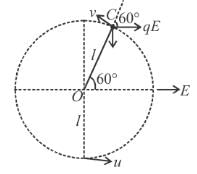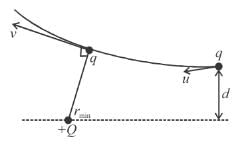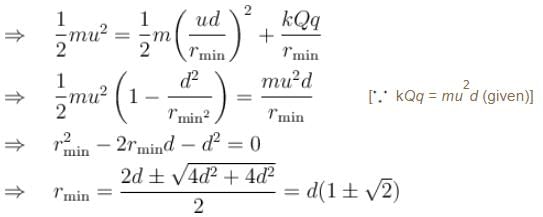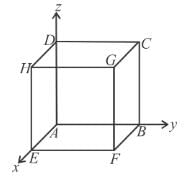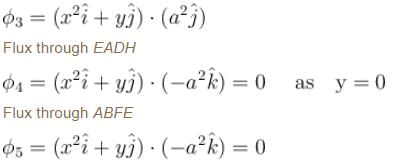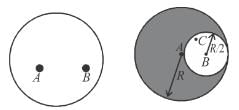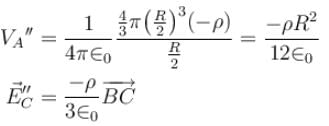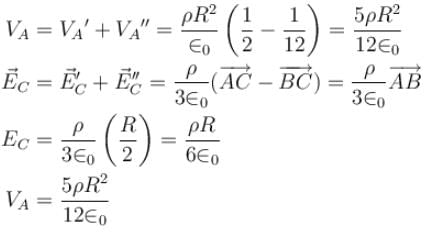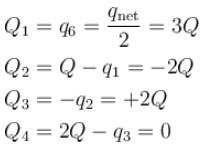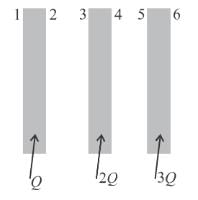Electrostatics NAT Level - 2 - Physics MCQ
10 Questions MCQ Test Topic wise Tests for IIT JAM Physics - Electrostatics NAT Level - 2
Figure shows a solid hemisphere with a charge of 5nC distributed uniformly throughout its volume. The hemisphere lies on a plane and point P is located on the plane, along a radial line from the centre of curvature at distance 15cm. The electric potential at point P (in volts) due to the hemisphere, is___.


A simple pendulum with a bob of mass m = 1kg, charge q = 5μC and string length l = 1m is given a horizontal velocity u in a uniform electric field E = 2 × 106 V/m at its bottom most point A, as shown in figure. It is given that the speed u is such that the particle leaves the circle at point C. Find the speed u.
(Take g = 10m/s2)
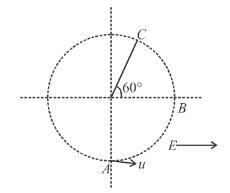
(Take g = 10m/s2)

| 1 Crore+ students have signed up on EduRev. Have you? Download the App |
A position charge +Q is fixed at a point A. Another positively charged. particle of mass m and charge +q is projected from a point B with velocity u as shown in the figure. The point B is large distance from A and at distance d from the line AC. The initial velocity is parallel to the line AC. The point C is at very large distance from A. Find the minimum distance (in meter) of +q from +Q during the motion.
Take 
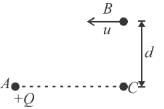


The electric potential varies in space according to the relation V = 3x + 4y. A particle of mass 10kg starts from rest from point (2,3.2)m under the influence of this field. Find the velocity of the particle in units of 10–3m/s, when it crosses the x-axis. The charge on the particle is 1μC. Assume V(x,y) are in SI units.
Consider a cube of side a = 0.1m placed such that its six faces are given by equations x = 0, x = + a, y = 0, y = +a, z = 0 and z = +a, placed in electric field given by  Find the electric flux crossing out of the cube in the unit of
Find the electric flux crossing out of the cube in the unit of 
A solid sphere of radius R has a cavity of radius R/2 The solid part has a uniform charge density ρ and cavity has no charge. The electric potential at point A is  then value of x is
then value of x is
A graph of the x component of the electric field as a function of x in a region of space is shown. The y and z components of the electric field are zero in this region. If the electric potential is 10V at the origin, then potential (in volts) at x = 2.0m is
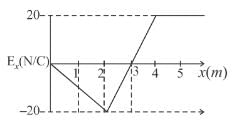
A dipole of dipole moment  is placed at point A(2, -3, 1). The electric potential due to this dipole at the point B(4, -1, 0) is equal to n × 109 volts. Find the value of n.
is placed at point A(2, -3, 1). The electric potential due to this dipole at the point B(4, -1, 0) is equal to n × 109 volts. Find the value of n.
A 4.00 kg block carrying a charge Q = 50.0μC is connected to a spring for which k = 100N/m. The block lies on a friction less horizontal track, and the system is immersed in a uniform electric field of magnitude E = 5.00 × 105 V/m, directed as shown in figure. If the block is released from rest when the spring is unscratched (at x = 0). By what maximum amount does the spring expand. (Answer in meters)

Three identical, conducting plane parallel plates, each of area A are held with equal separation d between successive surfaces. Charges Q, 2Q, and 3Q are placed on them. Neglecting edge effects. The sum of charges on the six surfaces is given by nQ. Find the value of n.





